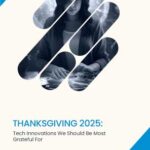or call: +1 (845) 347-8894

or call: +1 (845) 347-8894

Have you ever launched a sponsored campaign that looked promising on paper but failed to connect with the right readers? You are not alone. In tech media, where every reader wears a different outfit, whether it’s an architect, analyst, CTO, or procurement lead, sending one message to all simply does not work. What separates high-performing campaigns from the rest is not louder messaging but smarter targeting. That begins with audience segmentation for tech media. Done right, it ensures your content lands in front of the right eyes at the right time, driving results both publishers and sponsors can measure.
Tech publications are uniquely positioned. They attract highly specific audiences that span job functions, industries, and buying cycles. However, without precise segmentation, even the most informative content risks becoming noise. How can tech publishers deliver higher value to sponsors while building loyalty among readers? The answer lies in strategic, data-informed segmentation.
Segmentation allows publishers to divide their audience based on shared traits, behaviors, or interests. In the B2B tech space, this becomes critical due to the diversity of the professional audience. A software architect exploring edge deployment tools is not seeking the same information as a procurement lead evaluating SaaS contracts. Sending both individuals the same sponsored whitepaper may result in neither taking action.
Well-executed segmentation brings multiple advantages. It improves campaign alignment, enhances user experience, increases engagement rates, and delivers higher-quality leads to sponsors. Ultimately, it builds a media brand’s reputation as a credible, strategic partner in demand generation.
Tech publishers should move beyond generic audience filters. Here are five essential segmentation strategies that drive precision and performance.
This approach categorizes audience members based on business attributes such as industry type, company size, annual revenue, and geographic location. For example, if a sponsor provides cloud migration services tailored for mid-sized manufacturing firms, targeting enterprise finance firms would dilute the value of the campaign.
Firmographic segmentation helps match campaign exposure with sponsor goals. It ensures that resources are spent on the right audience groups, not just the largest ones.
Intent signals reflect a real-time interest in a topic or solution. These signals are captured through user interactions with content, downloads, and search queries. For instance, if a reader consistently explores topics related to network automation and downloads related reports, they likely have a high interest in enterprise networking tools.
By segmenting users according to this behavioral intent, publishers can align campaign messaging with immediate needs. This leads to better content relevance and stronger conversion performance.
This type of segmentation is based on how users engage with the platform. Key indicators include frequency of visits, time spent on articles, interaction with email newsletters, and participation in webinars. These behaviors reveal levels of interest and readiness.
Tech publications can use this data to segment audiences into high-engagement users, passive readers, or new visitors. Each segment can then be approached with tailored content or formats that match their level of commitment.
Segmenting audiences by job function helps ensure that campaign messages speak the right language. A C-level executive looks for strategic outcomes, while a technical user prefers specifications and integration details.
When publishers collect role data through gated content, event registrations, or surveys, they can map sponsored assets accordingly. For example, an executive summary works well for a CIO, while a product demo video may resonate more with a network engineer.
This strategy organizes users according to their stage in the buying journey. These stages typically include awareness, consideration, and decision. If a user is exploring broad educational content, they are likely in the early stages. If they are reviewing comparison guides, they are closer to making a decision.
Matching content type and tone to each stage increases campaign efficiency. Sponsors benefit when content guides users step by step, rather than jumping ahead to a call to purchase.
Executing segmentation at scale requires a robust tech stack. Leading B2B publishers rely on integrated systems to capture, manage, and act on data.
A CDP consolidates data from multiple channels, such as website visits, content downloads, and email interactions. It creates a unified audience profile that updates in real time. This allows publishers to segment based on both declared data and observed behavior.
Automation platforms help personalize content journeys. Based on user behavior, these tools can trigger follow-up emails, recommend sponsored articles, or assign leads to nurture streams. Publishers can segment audiences into active and dormant users, tailoring the campaign flow for each.
Artificial intelligence tools analyze past behaviors and suggest future content. For example, if a user has explored several articles on machine learning in healthcare, AI systems can recommend related sponsored webinars or case studies. This ensures that each interaction feels custom-made.
Connecting segmentation data to CRM systems helps track campaign results across the funnel. When combined with programmatic ad platforms, this data can also be used to extend targeting beyond the publisher’s owned properties.
APIs from providers such as ZoomInfo or Clearbit can fill gaps in user profiles. If a reader’s industry or job title is missing, enrichment tools can provide this information using firm-level signals. Enriched data allows for sharper segmentation and better lead scoring.
Effective segmentation is not complete without measurement. Sponsors expect more than impressions. They want insight into how their message reached specific segments and how it performed.
Publishers should track how each audience segment interacts with campaign content. Metrics include click-through rate, time spent on a page, and completion rate for forms or video content. These insights help refine future campaign strategies.
Lead generation is not just about quantity. Publishers should report conversion metrics by segment, such as lead-to-opportunity ratios or engagement depth. A highly targeted campaign may yield fewer leads, but each lead may be more sales-ready.
Campaigns often include several touchpoints. A user might first read a sponsored blog, later attend a webinar, and finally download a pricing guide. Multi-touch attribution helps publishers track the role of each segment in moving a user through the funnel.
Measuring how quickly users progress from awareness to consideration provides insight into content effectiveness. Faster progression often indicates that segmentation and messaging are well aligned.
For multi-phase campaigns, repeat engagement is an important indicator. Are users returning to explore related content? Are email open rates improving for specific segments? These answers help publishers shape long-term strategies and recommend follow-up campaigns to sponsors.
TechTarget, a global B2B tech media company, partnered with Demandbase to strengthen its segmentation model using third-party intent data. By identifying company-level buying signals and matching them with on-site behavior, TechTarget was able to enhance campaign targeting for a cybersecurity software client.
Approach
Results
This case validates how combining internal behavioral data with external intent signals can significantly boost sponsored campaign performance. It also reinforces the value of dynamic segmentation in a crowded tech media space.
At IntentTech Insights™, we specialize in decoding what drives performance in B2B media. Whether you are a publisher looking to enhance your segmentation strategy or a sponsor aiming to reach the right audience with precision, we help you turn insight into impact.
It is the practice of dividing readers into meaningful groups based on factors such as job role, company type, behavior, or buying stage. This helps improve content relevance and campaign outcomes.
It ensures that each piece of content reaches the audience most likely to engage, convert, or influence buying decisions, which increases the return on investment for sponsors.
They often use CDPs, marketing automation platforms, AI-driven personalization engines, CRM tools, and data enrichment APIs.
Through engagement metrics, conversion rates, attribution models, funnel velocity, and retention tracking across specific audience segments.
Segments should be reviewed at least quarterly. Behavioral patterns change, and data should reflect current audience interests and sponsor priorities.
To participate in our interviews, please write to our IntentTech Media Room at sudipto@intentamplify.com




